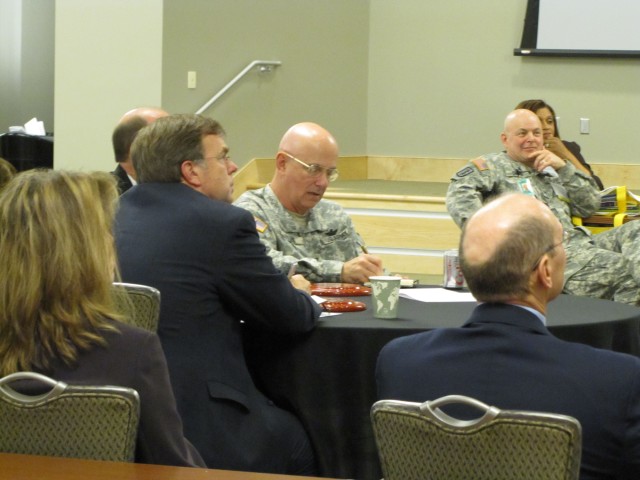REDSTONE ARSENAL, Ala. -- They didn't choose the military. But the military and all of the Tennessee Valley community has chosen to be there for them.
Nearly 2 million children across the world are connected to the U.S. military, according to the Military Child Education Coalition, half of whom have experienced a parent deployed to Iraq or Afghanistan. That's nearly 1 million children dealing with tough issues, such as a sick or injured parent, separation, cycles of deployment, post-traumatic stress disorder, and even death.
"We have to understand what it means to be uprooted, what it means when mom and dad come home and they're not the same mom and dad," Maj. Gen. Jim Myles, commander of the Aviation and Missile Command and Redstone Arsenal, said. "It's about turbulence. It's about how you deal with it. How do you deal with change when the abnormal is normal'"
Community leaders from across the Tennessee Valley gathered March 10 to reach out to the military child at MCEC's Living in the New Normal Public Engagement, a daylong session designed to help state and community leaders come together to create an action plan to support children in the community dealing with times of challenge due to the military lifestyle. The call to action is loud and clear - 5,000 children have come into the area since the announcement of BRAC in 2004, according to Myles, and another 8,000 are expected.
"This place is exploding," Myles said. "It's something we have to think about."
Living in the New Normal provides communities and families with research and resources to help respond to the challenges experienced in a military family environment. LINN leaders travel from state to state sharing their mission and information with community leaders, in the hopes that one day an action plan for children will be in place in each U.S. state.
"This is about America's kids," said Mary Keller, president and CEO of MCEC. "These are all of our kids. They're in every school and community. This isn't about the military taking care of the military; this is about all of us. The military child is a child first, and part of the military second. We are all responsible for our children."
Business, community, education, faith-based, healthcare and service leaders were given the opportunity to review the LINN research and brainstorm ideas for the Tennessee Valley, in addition to hearing from experts Patty Shinseki, wife of former Army chief of staff Gen. Eric K. Shinseki, as well as experts Col. Stephen Cozza and Kenneth Ginsburg.
"Children are brave and they're proud, and like their parents demonstrate the nobility of service," Shinseki said. "In order to work with children, we have to listen to them with our ears, eyes and certainly our hearts. The military community has a saying that we take care of our own, and it's a noble promise. What we give from the heart will live in the hearts of others and return tenfold."
Groups worked with each other throughout the afternoon to develop a plan to take care of the children of the Tennessee Valley. At the end of the engagement, they shared their insights and action plan with Myles, Huntsville mayor Tommy Battle and Madison mayor Paul Finley.
"What a way to tell people we care, we want you to come to our community," Battle said.
From their action plan, in the weeks and months to come, leaders will work to develop a consortium "to support children now and into the future," Garrison commander Col. Bob Pastorelli said. Needs specific to the children of the Tennessee Valley will be identified, so that resources can be directed to those areas. One of those resources will be a new website that will provide families with the information necessary to address whatever challenges their children may be facing.
"This is broader than just the military community," Myles said. "It's every kid that comes in. This is all of us. If you think it's just military, you're missing the party. And I don't think we're missing the party."
Editor's note: For more information on Living in the New Normal, visit www.linn.militarychild.org.




Social Sharing